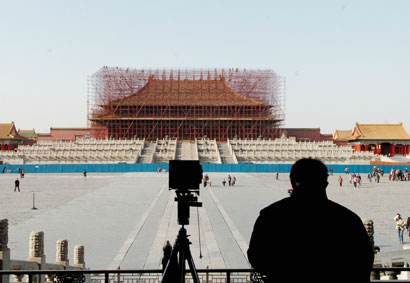After three centuries, Hall of Supreme Harmony, the heart of the Forbidden
City, is to receive its first facelift.
The palace, commonly known as the Jinluan Palace, which housed the
highest-ranking events the crowning of emperors and the declaration of wars
during the Ming (1368-1644) and Qing (1644-1911) dynasties and thus had the
greatest political importance of all buildings in the royal palatial complex.

A cameraman takes
a picture of the Taihe Hall, or the Hall of Supreme Harmony, which is
going to be renovated on March 28, 2006. The hall is the central and the
most important building of the Forbidden City in Beijing.
[Xinhua] |
The renovation will begin when Chinese and Italian conservation experts have
completed damage assessments in June, said Jin Hongkui, deputy director of the
Palace Museum, the administrative arm of the Forbidden City.
"We want to restore it to its original glory at the height of the Qing
Dynasty in the late 17th and 18th centuries by the time the renovation is
complete in 2007," he told China Daily.
"This vast building has never been touched, except for minor maintenance
work, since it was rebuilt in 1697 after being burnt down in a fire," he said.
"So we are very careful about how we handle it."
Experts from both the Palace Museum and the Italian Ministry for Cultural
Heritage are checking the conservation status of the building's framework, roof,
supporting pillars, the tiles on its top, the slabs on its floor, and the
colourful paintings under its eaves, the hardwood throne and silk screens.
"For each single piece of the palace we have to decide the specific materials
and methods to be applied on its cleaning and conservation," said Li Yongnian, a
chief conservationist at the Palace Museum.
Two of the four sides of the wooden palace's arched roof are sinking, while
the glazed tiles and supporting pillars also need urgent attention.
"We will mainly use centuries-old renovation skills as well as cutting-edge
technologies from our Italian colleagues," said Li.
"Fortunately we have families in our renovation team who have worked for
hundreds of years on these palaces. The skills that our ancestors used in
building the palace have almost all been handed down," he noted.
Renovations have been in full swing at the Forbidden City since 2002, with
works touching 17 palaces and gardens.
(China Daily 03/29/2006 page2)